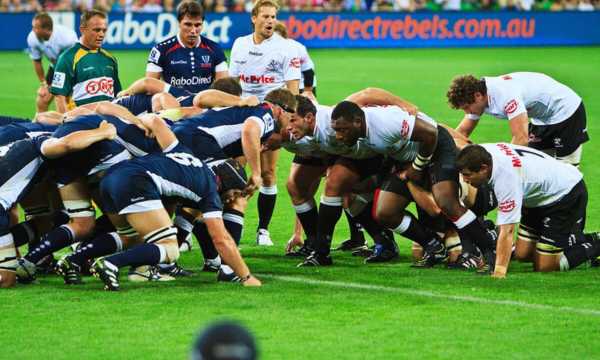Easy Guide to Rugby Union: Rules, Teams, and More Highlights
Rugby Union is a sport that combines strength, strategy and respect in a game that has won over millions of fans around the world.
Ad
Unlike other team sports, Rugby Union promotes values such as teamwork, integrity and courage.
If you’re just starting to follow matches or want to deepen your knowledge, this guide was made especially for you.
In the following sections, we’ll discover everything from the basic rules to the major world powers of this fascinating sport.
1. Know the Game with 15 Players
Rugby Union is played with 15 players on each side, divided between forwards and backs.

Learn more about Rugby Union (Google Source)
The forwards, numbered from 1 to 8, are the strongest players and responsible for set pieces like scrums and lineouts.
The backs, numbered from 9 to 15, are generally faster and more skilled with the ball in hand.
Each match lasts 80 minutes, divided into two 40-minute halves with a 10-minute break.
The field is rectangular with approximately 100 meters long and 70 meters wide.
The essence of Union is in territorial advancement with the oval ball, which can only be passed backward or sideways.
Kicking is allowed in any direction, creating interesting tactical variations during the game.
Basic positions in Rugby Union:
- Props and Hooker (1-3): Form the front row of the scrum.
- Locks (4-5): Tall and strong, they dominate the lineouts.
- Flankers and Number 8 (6-8): Mobile and highly competitive in defense.
- Scrum-half and Fly-half (9-10): Organize the game and distribute the ball.
- Centers, Wings and Fullback (11-15): Finish plays and defend open spaces.
2. How to Score Points in Rugby Union
There are four different ways to score, each with its own value and degree of difficulty.
The try is the most valuable form of scoring, worth 5 points when a player manages to ground the ball in the opponent’s in-goal area.
After scoring a try, the team is entitled to a conversion, worth 2 additional points.
The kick must be taken in a straight line from where the try was scored, increasing the difficulty depending on the position of the try.
Rugby Union also allows scoring through penalties (3 points) when infractions are committed. A specialist kicker can be decisive in close matches, converting penalties from long distances.
Drop goals are opportunistic plays, when a player kicks the ball (after letting it bounce on the ground) between the opponent’s posts during open play, adding 3 points to their team.
3. Lineout: The Aerial and Strategic Dispute on the Sideline
The lineout is one of the most strategic and visually impressive formations in Rugby Union, occurring when the ball goes out on the side of the field.
Two rows of players line up perpendicular to the touchline, separated by a one-meter wide corridor.
In Union, the lineout requires perfect synchronization between the thrower (usually the hooker) and the jumpers.
Secret codes and calls are used to coordinate where the ball will be thrown, creating a mind game between the teams.
Players can be lifted by their teammates during the lineout, reaching impressive heights to contest possession of the ball.
This lifting must be done with proper technique to ensure everyone’s safety. Tactical variations of lineouts in Rugby Union:
- Short lineout: Throw to the first jumper, seeking speed.
- Middle lineout: Balance between safety and offensive opportunity.
- Back lineout: Higher risk, but can surprise the opposing defense.
- Maul after lineout: Immediate formation of a maul after winning the ball.
Dominating the lineout can define control of the game, ensuring possession at critical moments. Teams with efficient jumpers often have an advantage in the aerial contests of this exciting sport.
4. Ruck vs. Maul: Understanding the Dispute for the Ball
The ruck and maul are two dynamic formations in Union that often confuse new spectators, but represent fundamental elements of the game.

Maul- Dynamic Rugby Formation (Google Source)
A ruck occurs when the ball is on the ground after a tackle and at least one player from each team is in contact, contesting possession.
During the ruck, players must stay on their feet, enter through the “gate” (area behind the last foot) and cannot use their hands to pick up the ball.
The team that generates more force and better technique usually comes away with possession.
A maul happens when the ball carrier is being held by an opponent and at least one teammate binds to the group.
In Rugby Union, the maul allows the ball to be passed between players who form the group. Main differences between ruck and maul:
- Ball position: On the ground (ruck) vs. in hands (maul).
- Primary objective: Push over the ball (ruck) vs. advance with the ball (maul).
- Ball handling: Prohibited in ruck, allowed in maul.
- End: When the ball comes out (ruck) vs. when it stops advancing or falls (maul).
Mastering these formations is essential for any team, as they determine the continuity of the game and the speed of ball possession, creating opportunities for attack or defense.
5. The Legal Tackle and the Offside Line
In Rugby Union, the tackle is the main means of stopping the opponent’s advance, but must follow strict safety rules.
A legal tackle must be made below the shoulder line, with the arms wrapping around the opponent and without turning or taking the player down in a dangerous way.
The concept of the offside line is fundamental and constantly changes during the game.
After a tackle, this imaginary line passes through the last foot of the last player in the ruck for each team, creating areas where players may or may not participate in the play.
Understanding tackle rules and the offside line is essential to appreciating the game and understanding referees’ decisions. Infractions in these areas often result in penalties or even cards.
Consequences for infractions in Rugby Union:
- Penalty: For technical infractions and less serious fouls.
- Yellow card: 10 minutes out of the game (sin bin)
- Red card: Permanent expulsion of the player from the match.
- Scrum or free kick: For minor infractions such as knock-on or forward pass.
The referee is the ultimate authority on the field and is traditionally treated with extreme respect by the players, reflecting the values of discipline and fair play in this sport.
6. The Great Rugby Union Tournaments
The Rugby World Cup, held every four years since 1987, is the most prestigious tournament, bringing together the best teams in search of the Webb Ellis trophy.
In the northern hemisphere, the traditional Six Nations Tournament brings together England, Wales, Scotland, Ireland, France and Italy in an annual competition full of history.
The unique atmosphere of packed stadiums and centuries-old rivalries make this tournament an incomparable experience.
In the southern hemisphere, The Rugby Championship is the main competition between South Africa, New Zealand, Australia and Argentina.
This tournament features a generally more open and offensive style of play, with favorable weather conditions. Main club competitions in Rugby Union:
- Champions Cup: Main European club tournament.
- Super Rugby: Elite competition in the southern hemisphere.
- Premiership (England): English league with high technical level.
- Top 14 (France): French league known for high investments.
These competitions reflect the global dimension of Union, with different styles of play and cultures that enrich the sport, attracting followers across all continents.
7. The Teams That Dominate the World Scene
In Rugby Union, some teams have established historical dominance due to their consistency and tradition in the sport.
- New Zealand, with their famous All Blacks, is widely considered the greatest power, with an impressive win rate of over 75% in international games.
- South Africa (Springboks) holds the record of three world titles (1995, 2007 and 2019), equaling New Zealand. Physical intensity and relentless defense are hallmarks of South African rugby over the decades.
- England was the first northern hemisphere team to win the Rugby Union World Cup in 2003. With one of the strongest domestic leagues, the English have always presented competitive teams in major international competitions.
Other powers in the sport:
- Australia (Wallabies): Two-time world champions known for creative play.
- France (Les Bleus): Known for unpredictable style and talented players.
- Ireland: Rose to the top of the world ranking with disciplined play.
- Wales: Historical tradition with periods of great dominance.
Competitive balance has increased, with nations like Argentina and Japan surprising traditional powers in recent World Cups, demonstrating the global expansion of this sport.
8. The Players Who Are Making Their Mark
Contemporary Rugby Union features extraordinary athletes who combine physical strength with impressive technical skills.
- Antoine Dupont, the French scrum-half, is considered by many to be the best current player, with his exceptional game vision and ability to instantly change the course of matches.
- In modern Union, players like Cheslin Kolbe (South Africa) prove that it’s not just physical size that matters. At just 1.71m, Kolbe has become one of the most admired wingers in the world thanks to his agility and bewildering steps.
- The Barrett brothers from New Zealand represent the athletic excellence of today’s sport. Beauden, Jordie and Scott frequently play together for the All Blacks, bringing versatility and exceptional skills to different positions on the field.
Modern Union requires increasingly complete athletes, who can contribute to both attack and defense, adapting to the rapid transitions that characterize the current game.
9. Impressive Facts About Rugby Union
Legend has it that the sport was born in 1823, when William Webb Ellis, a student at Rugby School in England, picked up the ball with his hands during a football game.
The highest score recorded in an international match was New Zealand 145-17 Japan, in the 1995 World Cup.
The All Blacks scored an incredible 21 tries in this display of superiority that went down in sport history.
Rugby Union has a strong tradition of respect and camaraderie, where opponents who fought intensely for 80 minutes often socialize together after matches.
The so-called “third half” is a unique tradition in this sport. Notable records in this form of rugby:
- Most international games: Alun Wyn Jones (Wales) with over 150 appearances.
- Highest scorer: Dan Carter (New Zealand) with 1,598 points in international games.
- Largest dedicated stadium: Twickenham (England) with a capacity for 82,000 spectators.
- Longest match: Australia vs France in 2010, with 100 minutes due to overtime.
Union is played in more than 100 countries, but only 20 qualify for the World Cup, demonstrating the balance between tradition and global expansion that characterizes this sport.
10. Understand Expressions Used in Rugby Matches
Rugby Union has its own vocabulary that may seem incomprehensible to new fans.
The term “knock-on” refers to when a player drops the ball forward, resulting in a scrum for the opposing team.
“Advantage” is an important concept, allowing play to continue after an infringement when the non-offending team is in an advantageous situation.
The referee can return to the original penalty if the advantage doesn’t materialize.
Commentators frequently mention the “offload”, which is the ability to pass the ball to a teammate during a tackle, maintaining the continuity of the attack before going to ground.
Other common expressions:
- Breakdown: Situation after the tackle where possession is contested.
- Set piece: Fixed formations such as scrum and lineout.
- Pass exposed: A pass that puts the receiver in a vulnerable position for a hard tackle.
- Turnover: When one team handle ball possession from the other.
Mastering this specific vocabulary significantly enriches the experience of watching rugby, allowing better understanding of strategies and referees’ decisions during matches.
Conclusion
Rugby Union transcends the simple status of sport to become a global culture with deeply rooted values of respect, teamwork and courage.
The constant evolution of rules and tactics keeps the sport relevant and exciting for new audiences, without abandoning its centuries-old traditions.
As it continues its global expansion, new talents emerge from non-traditional countries, enriching the game with different perspectives and styles.
This form of rugby offers an incomparable sporting experience that combines physical intensity with strategic richness, creating unforgettable memories on and off the field.
FAQ
Why don’t players wear protection like in American football?
Which country has the most Rugby Union world titles?
What are the biggest rivalries in Rugby Union?
How does the World Cup qualification system work?
How does the TMO (Television Match Official) work?
 Want to Watch Rugby Live on Your iPhone? Discover the Best Apps
Want to Watch Rugby Live on Your iPhone? Discover the Best Apps
Watch all the games directly on your iPhone, follow every play in real-time and never miss a thrilling moment, wherever you are. Ad Tired of missing […]
Keep reading Rivalries and Unmissable Matches in the United Rugby Championship
Rivalries and Unmissable Matches in the United Rugby Championship
Dive into the heart pounding world of the United Rugby Championship where legendary rivalries create unforgettable sporting moments. Ad This championship has become the ultimate battleground […]
Keep reading Watch NRL Live: Best Apps for Android
Watch NRL Live: Best Apps for Android
With NRL live apps, rugby fans can catch favorite matches anytime, even when busy or away from home. Ad With the right Android apps, you can […]
Keep reading